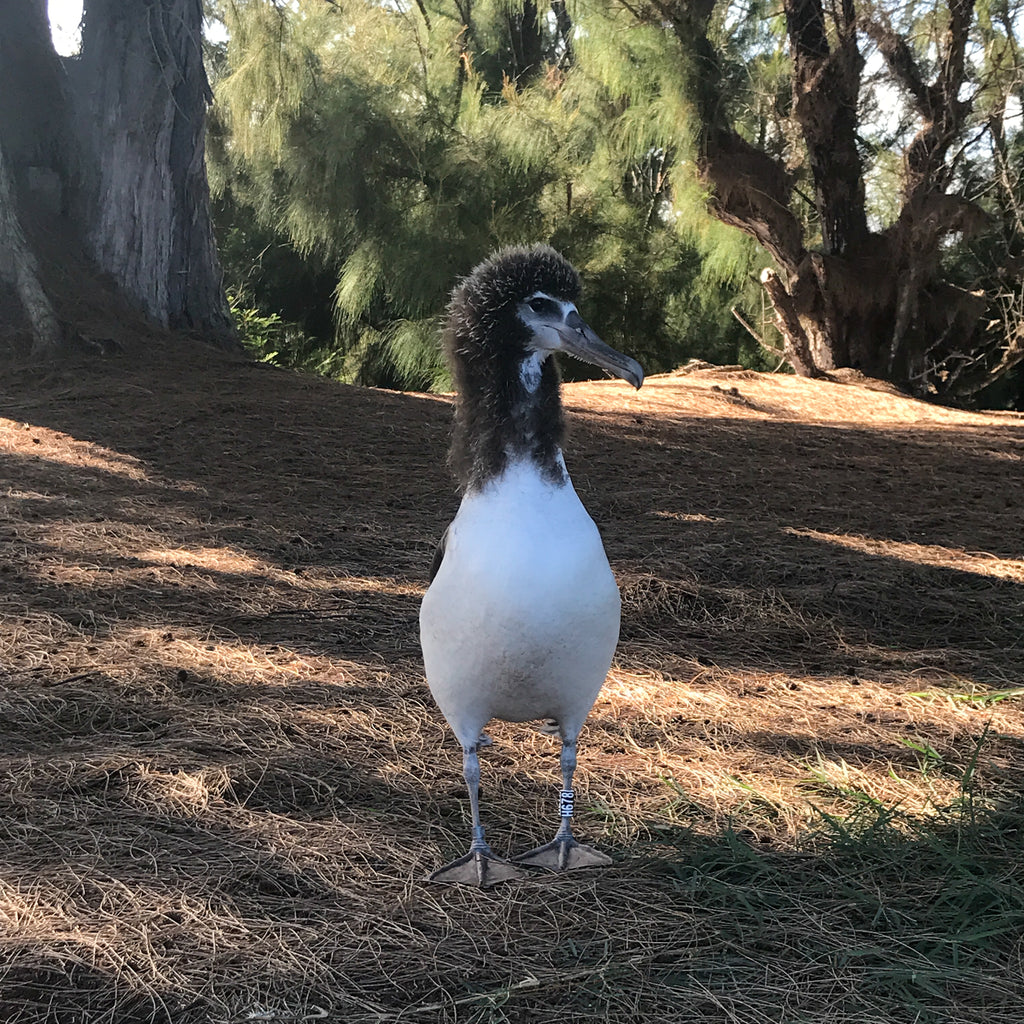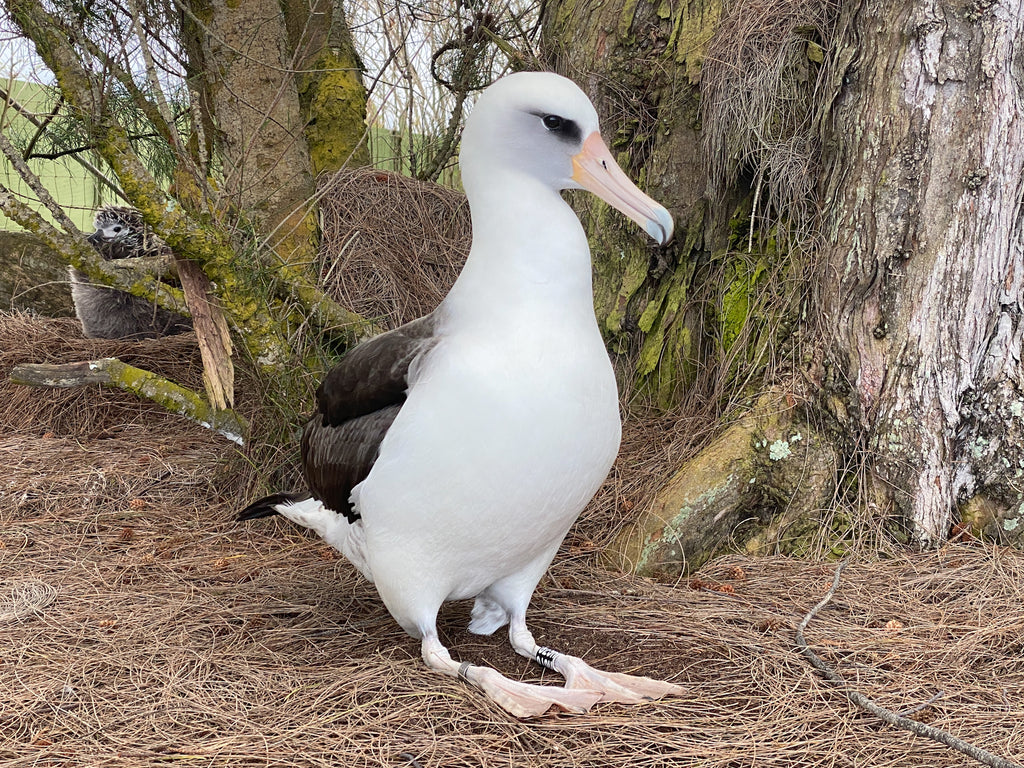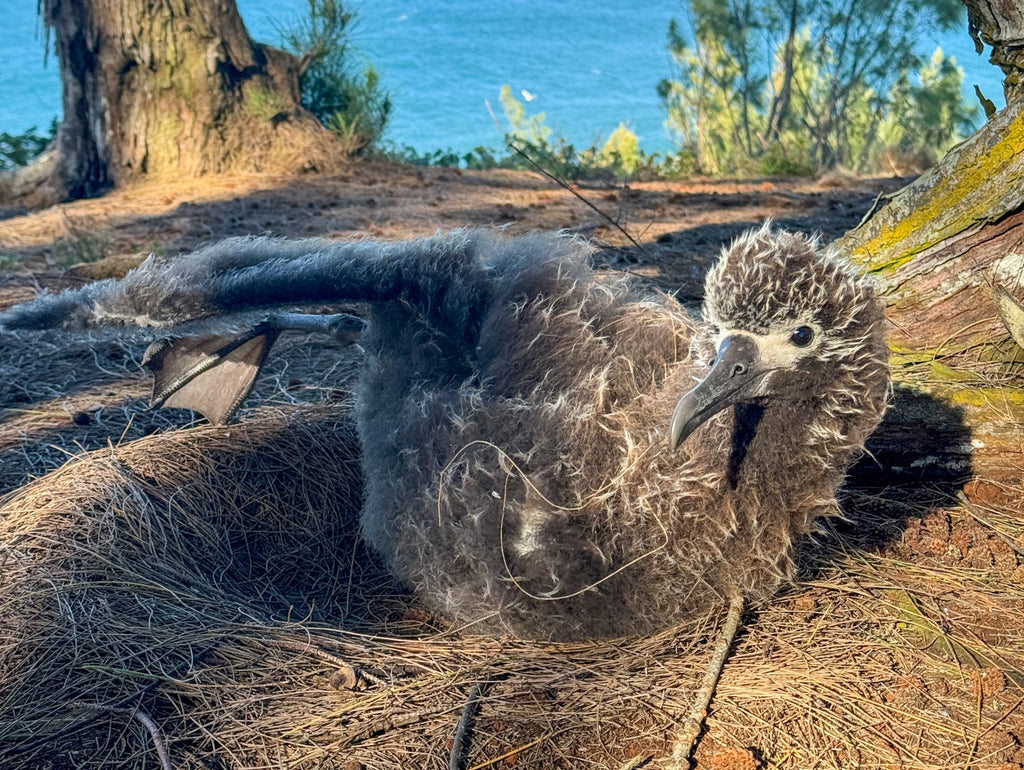Meet our friends the Laysan albatross
The Laysan albatross, known as Mōlī in Hawaiian, are magnificent seabirds that range across the North Pacific. Though they mainly nest in the Northwest Hawaiian Islands on Midway Atoll and Laysan Island, we're fortunate to have a small colony on the bluff fronting our Noni orchards.
Genuine Lovebirds
These magnificent seabirds are monogamous and pairs mate for life. Engaging in elaborate dances, they perform around twenty-four distinct moves that are intricately combined into a unique sequence for each couple.
Long lifespans
The oldest known banded bird in the wild is a female Laysan albatross named Wisdom. She nests on Midway and is at least 75 years old.
Experts in the air
Laysan albatross spend about 90% of their lives airborne and fly at speeds up to 50 miles per hour. They can stay airborne for days, navigating with half their brain while the other half sleeps.
Adorable Chicks
They hatch the cutest chicks! With your help we select a superstar each season and follow their journey from hatch to fledge. Last season we saw a chick fledge for the first time ever, that chick just so happened to be our superstar Lucky!
We are so EXCITED to share all the happenings of this year's nesting season with you!
November 2023
The first arrivals of the season are here!
Our colony’s first arrival touched back down on the bluff early Sunday morning on November 12th. By the next day we spotted five birds, then ten, by the following week twenty-two with more arriving daily.
From mid November through early December our nesting pairs return from months of solitude at sea. The male birds almost always arrive first, eager to reunite with their mate. She may arrive the next day, week or even two weeks later.

One of our first reunited pairs snuggled up
When a pair finally reunites their joy and excitement is simply off the charts. This is the first time they’ve seen each other in months. They squeal and sing in delight, spend hours snuggling and preening each other, mate, and then depart for the sea once again, solo for a short feeding trip lasting about a week. She will return first, build their nest and lay their one egg for the season. She then patiently awaits the return of her mate for his shift on egg incubation duty.
December 2023
Egg laying is complete with 25 nests this season. We have nests from many of our veteran nesters, a couple of first-time nesters and even a pair of widows who after many seasons have found new love in each other.

Mama bird building her nest
Albatross are ground nesters
The nest is started by Mama bird and finishes touches completed by Papa bird. She uses her beak and feet to dig a shallow depression in the ground, pushes out the dirt to build up the surrounding rim and then reinforces the sides by pulling in the surrounding pine needles.

Mama bird tenderly admiring her newly laid egg
When Papa bird returns and takes over nest duty he will continue to reinforce the nest by pulling in pine needles with his beak. Once their egg is laid, one parent will always be in the nest on the egg keeping it warm and protected while the other is out feeding.
Egg Adoption Day
Every year in mid December a skilled team of biologists assess the fertility of each egg in our colony. One biologist gently retrieves the egg from beneath the nesting parent and passes to a second biologist who swiftly candles and examines the egg inside a wearable darkroom.
If the egg is fertile it is returned promptly to the nest. If the egg is infertile it is removed and a fertile “adoptive egg” is returned to the nest in its place. Either way the nesting parent happily settles back on their egg.
Where do these "extra" fertile eggs come from?
The Pacific Missile Range Facility on Kauai's West side is home to nesting albatross, posing an air traffic collision hazard. USDA Wildlife Services biologists monitor and relocate fertile eggs, placing them in nests with infertile eggs in other protected albatross colonies on the north shore of Kauai.
Adoptive eggs are transported in a protective and heated carrier
Albatross exhibit a high degree of natal philopatry, which means chicks return to the placed they hatched to breed. By relocating fertile eggs off the missile base the chicks then hatch and imprint on their adoptive colony as home. Over time this removes the air traffic hazard while also helping other colonies grow.
We are beyond grateful for the collaboration of federal, state and private entities that make this egg adoption program possible. We had 5 nesting pairs this season that received an adoptive egg and now have the chance to hatch a chick.
January 2024
January marks the return of the juvenile aged birds to the breeding colony. These are the 4 to 7 yr olds who will begin to learn the synchronized movements of their courtship dance in order to attract their lifelong mate.
We're always eagerly watching for the leg band IDs of any of our superstar chicks. We've spotted both Kai (2016) and Ruffles (2017) already this month on the bluff socializing and dancing. This Spring could mark the anticipated return of Elvis (2018) and/or Spike (2019) to land for the first time since they fledged in their respective years.

Two juvenile birds practicing their courtship dance
Albatross dance video goes global
The singing and dancing has already begun! Did you catch our latest albatross dance video post? It’s now been viewed over 600,000 times!
If you don't have Facebook we also have the video on our YouTube
January 29th update: We have egg-citing news!
The first of many albatross chicks has hatched in our colony. On Sunday morning's bluff check we were blessed with the sight of the cutest ball of fluffy feathers nestled under Mama. Since then, two more chicks have hatched and six more eggs are pipping which means absolute cuteness overload coming soon!
Our first hatched chick nestled at Mama's feet
February 2024
Eggs are pipping & chicks are hatching!
The "pip" is the first little hole made by the chick to the outside world. It then takes 2 to 3 days for the chick to slowly chip away at its eggshell and fully hatch.
Egg pip and chicks little beak
After hatching, the chicks spend their days nestled under the protective warmth of Mom or Dad, who take turns between nest duty and foraging for squid. In between all the napping the chick will receive regular feedings of regurgitated stomach oil, promoting rapid growth and strength.
Adorable chick nestled at parent's feet
At about 2 weeks old the chick reaches their next significant milestone: being left alone in the nest. The chick's insatiable appetite for regurgitated fish eggs and squid demands both parents to forage simultaneously. Initially, the chicks experience short periods alone in their nest, gradually extending to overnight stays, and eventually, they spend days at a time without a parent.
Hatching is complete
We started the season with 25 nests and 17 adorable chicks have hatched! The remaining 8 nests will unfortunately not have a chick this season— five nests were abandoned, one egg broke, one egg failed to hatch and sadly one chick did not survive.
March 2024
The first hatched chicks are already solo in their nests. When not napping the chicks have no shortage of entertainment as the young juvenile birds are arriving daily, some afternoons we've counted 30 to 40 juveniles flirting and dancing on the bluff.
Chick being fed by parent
BIG NEWS: Elvis has returned!
Remember Elvis? He was our 2018 Name that Chick superstar! After fledging at 6 months old in July of 2018, he has been living life in the vast North Pacific Ocean for the last 5 1/2 years. Last week, we spotted him back on land for the very first time! And not just any land—the very bluff where he hatched as a chick 6 years ago. Talk about having an expert internal GPS to guide you home. How do we know it's Elvis? He is banded and his special digits are H678.
Elvis at 6 months old (July 2018)
Elvis at 6 years old first return to land sighting (March 2024)
We expect to see him return for a couple of months every Spring as he flirts and dances with potential suitors. Then, one year, we'll spot him back, not in the Spring but in November. This will be the telltale sign he's chosen a mate, and we'll keep our fingers crossed she also returns in November and officially become mates for life.
April 2024
We are gearing up to kick off our annual Name That Chick Contest! We need your help selecting which one of this year's adorable albatross chicks will be the superstar.
This year, we held off voting until the chicks were a bit older. We hope their little personalities shine through their photos to help you select your favorite. We also listened to your feedback and did our best to level the playing field by selecting photos of the chicks in similar poses.

The votes are in and we have our superstar!
The number of votes cast to select this year's cutest chick has surpassed all years past. The vote tally started off close and then one adorable chick ran away with the win. Can you guess who?

Adorable Chick C captured the win with their extra spunk and windblown feathers.
May 2024
Last call at the singles bar
About a dozen of our colony’s juvenile birds are lingering on the bluff, hopeful to have one last flirtatious dance before once again departing for months at sea.
No signs of Spike (2019) this year but we did welcome home Elvis (2018) for the very first time this season! Our superstar chicks Kai (2016) and Ruffles (2017) have both danced and mingled for a few singles seasons and seem to have each cozied up with potential mates. Have they found their lifelong mate? We will find out next season.
Chick C is now 15 weeks old
Albatross chicks rely solely on their parents for meals. Chick C is quickly growing in size which means Mom & Dad must forage further and longer for more hefty meals of squid and fish. Chick C is currently waiting about a week between feedings giving him or her the perfect opportunity to explore the bluff, make new nests and play with pine cones and twigs on the ground. Dad returned earlier this week and delivered a hefty regurgitation of squid and fish.

Dinner is served. Chick C is fed by Dad
June 2024
Chick C and friends are sporting their "bling"
Full grown albatross are virtually identical, so how do we know who is who within our colony? It's their unique ID on their leg band that helps us tell them apart, know who survives at sea and who mates with whom. The wonderful team with US Fish and Wildlife came last week and all our chicks are sporting their new leg bands aka "bling."
The banding process for each chick is quick, taking about 30 seconds, and it's the only time the chicks are ever handled by humans. One biologist swiftly picks up and holds the chick and the second biologist smoothly fastens a band on each leg. The metal federal band is placed on the right leg, and the larger auxiliary plastic band is placed on the left. It's the auxiliary band ID that we keep record of for all our chicks as it can be seen clearly with binoculars. Chick C's unique digits are J306.
Our superstar Chick C is now banded
While Chick C was being banded, the biologists collected a feather which was sent in for DNA analysis for gender. Chick C is a GIRL!
July 2024

We have a big announcement
Meet Phyllis
Many mahalos to everyone for the fantastic name suggestions—we received over 400 fun and creative names! After a grand family debate, we decided that Phyllis is the perfect name for this year's superstar.
And yes, the name Phyllis of course comes with a back story.
Many of you might remember Phyllis Diller, the very funny comedian who appeared on shows like Jack Paar, Johnny Carson, and David Letterman, as well as her own sitcoms. Steve personally knew her and had the great fortune to travel with her on vacations and to shows in places like Las Vegas, New York City, and even on a boat cruise to the Caribbean Islands for 10 days.
She always sported a wild, wind-blown hair look, but most importantly, she brought countless laughs thereby helping many people to relax and enjoy life. Phyllis was not only intelligent and funny but also had a loving nature, caring deeply about everyone she met.
So fly on, Phyllis, and keep us happy!!
Congratulations Lee, Deborah and Robyn! You'll be receiving not only a Noni gift parcel but, more importantly, bragging rights for 2024.
Two of the chicks in our colony fledged last weekend, and Phyllis is most certainly acting like she’s next in line to take flight.
July 10th: Phyllis has fledged!
This past week, Phyllis showed signs of readiness: standing on the bluff edge staring at the ocean, preening her wings for hours, and vigorously flapping her wings into the wind as rain squalls passed through. Then one morning, she took flight for the very first time, soaring off into her next grand adventure at sea.
Phyllis 3 days before she fledged
She will spend the next 5 years living out at sea. She will not touch land again until she returns as a young juvenile back to this very bluff she hatched. The earliest we may see her again is in the Spring of 2029.
Phyllis was 160 days old and the 3rd chick to fledge from the colony this season. So far 7 chicks have fledged and 4 remain.
We did not witness Phyllis take flight, it literally happens in an instant. In all these years we’ve only seen one of our chicks fledge in person. That chick just so happened to be last year’s superstar Lucky and by some miracle we also caught it on video. Watch Lucky's fledge video
If you don't have Facebook we also have the video on our YouTube
August 2024
Parents of our final chicks to fledge are currently foraging up to 5,000 miles over 7 to 10 days to bring back a single squid meal for their chick. Albatross are experts in the air. Flying at speeds of 50 mph and have the amazing ability to navigate with half their brain while the other half sleeps.

Chick giving her Mom the "where's the squid" look
When a parent returns to deliver a meal, there is no time to rest. They feed their chick in under 15 minutes, give them a little pep talk about preening their feathers for fledge and then take flight foraging for the next meal.
The chicks have fledged and the bluff is quiet
Albatross nesting season 2024 has officially come to a close. We had a smaller fledge count this season with just ten adorable chicks, including this year’s superstar Phyllis! The chicks will spend the next 4 to 7 years living life in the vast North Pacific Ocean. They will not touch land again until they return back to this very bluff they hatched when they are of age to find a mate.
Superstars of years past ~ Kai (2016) and Ruffles (2017) both cozied up with potential mates this season, if they return in November we’ll know they’ve made a match! Elvis (2018) made his first appearance since he fledged and wasted no time dancing with potential suitors. No signs of Spike (2019) but we saw many of his fledge class return for the first time this Spring, we hope next year is his year.

The albatross nesting bluff will be quiet for the next few months but come early November the adult birds will return once again from life at sea and kick off nesting season 2025. Safe travels to Phyllis and friends, we hope the winds are kind and the squid very plentiful!
We hope you have greatly enjoyed following this season with us! Stay tuned for first sightings in November.
What did you enjoy most about this season? Please let us know in the comments below :)
14 Comments
Thank you so much for always sharing your Albatross stories. I love them. It’s so joyful watching them come back, mate, dance, have baby chicks and then off they go.
What a lifecycle! Hope they make safe passage back this November! 💕
Be safe Phyllis send many prayers for you as you set off on your Great Adventure. May the winds always be at your back ❤️
Ha! Our Phyllis looks as disheveled as always❣️ How exciting!! Best of luck to her and all the other fledglings.
That is a Perfectly Beautiful name for this Sweet Girl. I used to call my daughter Phyllis Dillar when she would wake up in the mornings. Her hair was always Crazy 🤪
Noni keeps my shingles away. When I was in the hospital from an appendicitis I didn’t have it and I got shingles. That’s amazing!
Write a Comment